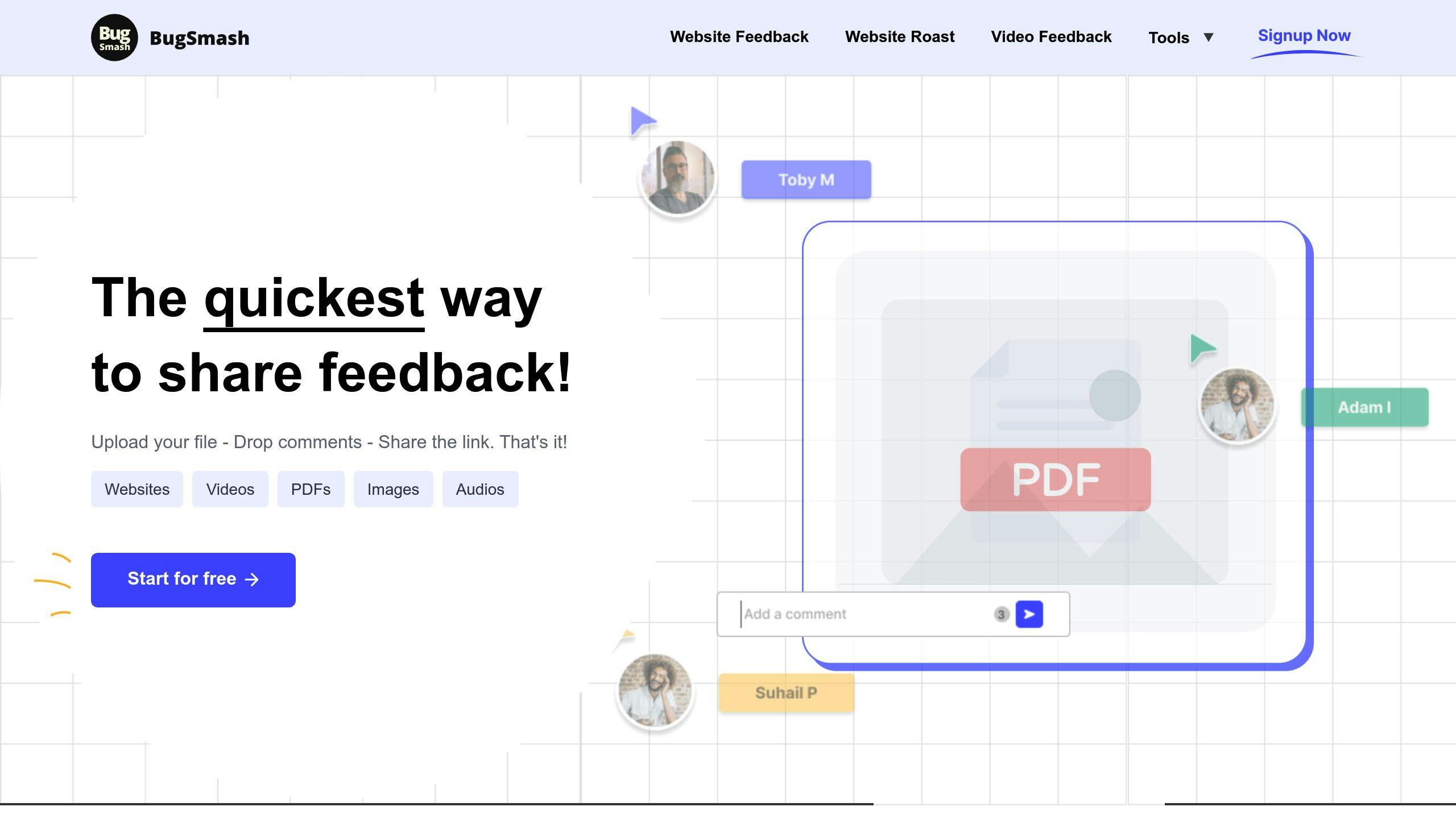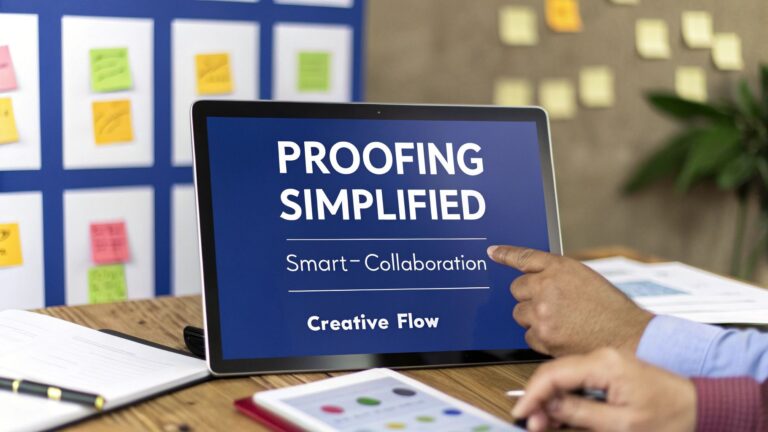Managing client feedback effectively is essential for agencies to deliver successful projects and maintain strong client relationships. Poor feedback handling can lead to delays, miscommunication, and unnecessary revisions. Here’s how to streamline the process:
- Set Clear Feedback Rules: Define what actionable feedback looks like (context, description, expected outcome, priority).
- Centralize Feedback: Use a single platform to collect, organize, and track feedback (e.g., BugSmash).
- Schedule Regular Sessions: Avoid surprises by reviewing progress and addressing concerns consistently.
- Respond Quickly: Acknowledge feedback within 24 hours to build trust and set expectations.
- Prioritize and Act: Categorize feedback by urgency and impact, then turn it into actionable tasks.
Quick Comparison of Feedback Channels
| Channel | Main Issue |
|---|---|
| Difficult to track versions | |
| Chat Applications | Hard to maintain context |
| Phone Calls | Lack of documentation |
| Project Management Tools | Consistency challenges |
Client Feedback 101: How to Use it to Improve Your Agency’s Services
Common Problems in Managing Client Feedback
Handling client feedback can be tricky for agencies, no matter their size. Here’s a closer look at the common challenges that can slow down the process and affect project outcomes.
Scattered Feedback Channels
When feedback comes in through emails, chats, phone calls, and project tools, it’s easy for things to fall through the cracks. Information gets lost, responses are delayed, and version tracking becomes a nightmare. Keeping everything in one place is crucial to avoid these headaches [1].
Here’s how different channels can complicate things:
| Communication Channel | Main Issue |
|---|---|
| Difficult to track versions | |
| Chat Applications | Hard to keep context intact |
| Phone Calls | Lack of proper documentation |
| Project Management Tools | Maintaining consistency |
Juggling multiple platforms can create logistical chaos. But even when feedback is well-organized, its clarity can make or break a project.
Vague Feedback
Comments like "make it pop" or "this feels off" leave teams guessing. Without clear direction, it’s tough to turn subjective opinions into concrete tasks [2]. Agencies need to guide clients toward giving actionable input.
The ripple effects of unclear feedback include:
- Delays and increased costs
- Frustrated teams and lower productivity
- Strained relationships with clients
Even with clear feedback, the next challenge is figuring out how to prioritize and act on it effectively.
Organizing and Prioritizing Feedback
Without a clear system, teams can get overwhelmed trying to decide what needs immediate attention and what can wait [1]. This becomes even harder when different stakeholders offer conflicting suggestions [2].
Here’s a breakdown of how different types of feedback affect projects:
| Feedback Type | Impact on Project |
|---|---|
| Design Updates | Affects user experience and visuals |
| Content Changes | Shapes brand messaging |
| Feature Modifications | Impacts scope, timeline, and resources |
Tackling these challenges requires a structured approach, which we’ll dive into in the next sections. By addressing these issues, agencies can streamline their processes and keep clients happy [1].
Effective Strategies for Managing Client Feedback
Handling client feedback effectively is crucial for agencies looking to keep projects on track and meet client expectations. Here are some practical ways to improve how feedback is managed.
Set Clear Feedback Rules
Clear guidelines for feedback can prevent confusion and make input more actionable. These rules help avoid issues like vague comments or scattered communication, ensuring feedback is organized and useful.
| Feedback Component | Required Elements |
|---|---|
| Context | Specify the location (e.g., page or feature) |
| Description | Provide a detailed explanation of the issue |
| Expected Outcome | State the desired result |
| Priority Level | Highlight the impact on timeline or goals |
"Client input is essential in fast-changing industries like digital marketing" [1].
Once these rules are established, regular feedback sessions can help maintain alignment and avoid last-minute surprises.
Plan Regular Feedback Sessions
Instead of waiting for issues to arise, schedule regular review cycles. These sessions can:
- Compare progress against project objectives
- Address client concerns and questions
- Document decisions and establish next steps
- Set clear timelines for necessary changes
This proactive approach ensures smoother communication and fewer misunderstandings.
Use a Single Feedback Platform
Centralizing feedback in one platform simplifies the process and keeps everything organized. Tools like BugSmash make it easy to collect input, add annotations directly to projects, and track changes efficiently [1][2]. By combining a single platform with clear rules and scheduled sessions, agencies can streamline feedback and keep projects moving forward.
sbb-itb-54a62c3
Tools to Simplify Client Feedback Management
Once you’ve got your feedback strategies in place, the next step is choosing the right tools to make managing it easier and more efficient.
BugSmash

BugSmash helps you gather and organize feedback from different media formats, solving the problem of scattered communication. It allows users to leave direct annotations on websites, mobile apps, videos, images, and PDFs. Plus, it tracks changes in a centralized dashboard, giving you a clear view of all project feedback in one place.
| Feature | How It Helps Agencies |
|---|---|
| Multi-format Support | Collect feedback from websites, apps, and media in one spot |
| Direct Annotation | Highlight issues without long explanations |
| Version Control | Keep track of updates across different versions |
| Unified Dashboard | Monitor progress easily and efficiently |
Other Feedback Management Tools
There are other tools tailored to specific needs. For instance, BugHerd lets you annotate websites directly in a browser and integrates with project management tools. MarketMuse, on the other hand, focuses on SEO content analysis, offering insights to improve your content strategy.
Connecting Feedback Tools to Project Management
Pairing feedback tools with project management software ensures that feedback turns into actionable tasks. This integration keeps communication clear, tracks progress, and helps avoid delays caused by miscommunication. It’s all about making the workflow between client input and team execution as smooth as possible.
Tips for Responding to Client Feedback
Handling client feedback well means acting quickly, focusing on solutions, and maintaining professional communication. Here’s how agencies can excel in these areas.
Acknowledge Feedback Quickly
Responding promptly to client feedback can help retain customers and increase revenue [1]. A simple confirmation email or message within 24 hours reassures clients that their concerns are being taken seriously. Even if a detailed reply takes longer, this initial acknowledgment sets expectations.
| Response Type | Timeframe | Purpose |
|---|---|---|
| Initial Acknowledgment | Within 24 hours | Confirm receipt and establish expectations |
Using tools like BugSmash can simplify the process of acknowledging and tracking feedback, ensuring nothing slips through the cracks.
Focus on Solutions
Acknowledging feedback is just the first step – offering practical solutions is what truly matters. Agencies that address feedback with clear action plans often see happier clients and smoother processes.
Ways to stay solution-focused:
- Break down feedback into actionable steps.
- Set clear timelines for implementing changes.
- Offer alternative solutions if requests aren’t possible.
- Regularly update clients on progress and milestones.
While solutions are crucial, how you communicate them can make or break the client relationship.
Communicate Respectfully
Respectful communication is key when discussing feedback. Here’s how to keep the conversation constructive:
- Thank clients for their input.
- Keep detailed records of all feedback discussions.
- Maintain a positive tone throughout.
- Emphasize actionable and constructive responses.
Professional and respectful dialogue helps build trust and ensures feedback drives meaningful improvements. By combining quick responses, solution-oriented actions, and respectful communication, agencies can transform feedback into opportunities for stronger client relationships.
Conclusion: Improving Client Feedback for Better Results
Managing client feedback effectively is crucial for running a successful agency. With a structured approach, agencies can transform disorganized input into practical insights, tackling challenges like unclear communication and ambiguous feedback.
Research highlights that agencies using organized feedback systems experience noticeable improvements in client satisfaction and project results [1]. These advancements stem from three main areas:
Centralized Communication Channels
Using a single platform for feedback eliminates the chaos of juggling multiple channels. This approach allows teams to track progress, maintain accountability, and manage projects more efficiently.
Organized Feedback Collection
A systematic process beats ad-hoc methods every time. Studies show that structured feedback systems lead to faster response times, higher completion rates, and greater client satisfaction compared to traditional methods [1].
| Aspect | Traditional Method | Structured Approach |
|---|---|---|
| Response Time | 48-72 hours | Within 24 hours |
| Feedback Implementation | 60% completion rate | 85% completion rate |
| Client Satisfaction | Moderate | High |
Tech-Driven Solutions
Modern tools for feedback management have revolutionized how agencies handle client input. These platforms make it easier to provide detailed, context-specific feedback while streamlining workflows and enhancing team collaboration.
Improving feedback management involves refining processes and leveraging the right tools. Centralizing feedback and maintaining clear communication not only strengthens client relationships but also leads to better project outcomes.
Effective feedback management goes beyond simply gathering input – it’s about creating a system that turns feedback into actionable improvements. Agencies that adopt these methods can build trust, foster strong client partnerships, and gain a competitive edge by delivering consistently better results [2].
FAQs
How do you handle feedback or revisions from clients?
Agencies typically rely on structured systems to manage client feedback effectively. Here’s an example of a streamlined process:
| Phase | Action | Expected Outcome |
|---|---|---|
| Initial Setup | Define feedback rules and communication channels | Clear expectations and smoother communication |
| Collection | Use tools like feedback management platforms | Centralized and trackable feedback |
| Processing | Prioritize and categorize feedback | Organized workflow for revisions |
| Implementation | Document changes and share updates | Transparent and efficient revision process |
For example, ABC Digital enhanced client satisfaction and delivery efficiency by using tools like BugSmash to manage feedback [1].
How can agencies ensure feedback leads to improvement?
Research highlights that agencies with consistent feedback collection and analysis processes often achieve better client retention and increased profit margins [1].
"Active listening ensures clients feel valued and fosters trust" [2].
What are best practices for organizing client feedback?
Organizing client feedback effectively involves breaking it down into categories like service quality, communication, and timeliness. This approach helps agencies:
- Spot Patterns: Identify recurring themes and prioritize fixes.
- Track Progress: Measure how successfully changes are implemented.
- Stay Accountable: Keep records of changes and monitor their resolution.
Structured systems can significantly boost feedback efficiency. For instance, agencies using these methods often see completion rates of 85%, compared to 60% with less organized approaches [1].
How quickly should agencies respond to client feedback?
Acknowledging feedback within 24 hours is key, even if resolving the issue takes longer [2]. Quick acknowledgment, clear timelines, and regular updates help maintain transparency and trust.
This responsive approach strengthens client relationships and ensures steady project progress [2].



